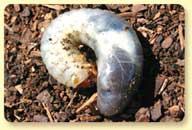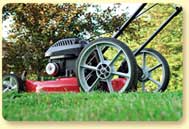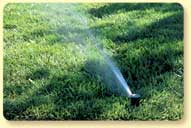
Grubs Rubbing You the Wrong Way?

White grubs are the larval stage of several types of beetles. The adult beetles don’t do any harm to lawns, but the grubs can completely destroy turf if they’re not controlled.
Life Cycle
These insects go through four life stages: egg, grub (larva), pupa and adult. The adults lay their eggs in lawns in mid to late summer, and the eggs hatch two to three weeks later into grubs. The grubs live in the soil under the thatch layer, feeding on grass roots through late fall. They then overwinter in the soil and feed again in the spring before pupating and emerging as adult beetles.
A Hidden Threat
Since they’re hidden below the thatch layer, grubs can go unnoticed while they eat the roots out from under your lawn. That’s why it’s important to perform a periodic grub check. You can do this by pulling up a small patch of turf with your hands. If the turf pulls up easily, and you see white grubs in the soil, control will be needed.
Control
A variety of control options can be used to stop grubs from damaging your lawn. They should be treated before damage begins to appear, or as soon as they’re discovered. Either way, remember that they won’t disappear on their own! Give King GREEN a call today for more information or to schedule grub control for your lawn.
Mowing: A Hot Summer Topic

No matter how you cut it, mowing has a lot to do with keeping your lawn in good shape. Here are some tried-and-true mowing tips for the summer season:
Height to Set Your Mower:
Grass needs its leaves to produce food and to shade and cool the soil. The ideal height for most grasses is 2 1/2" to 3" in hot weather (1/2" to 1" shorter when it gets cool).
How Often to Mow:
Mow often enough so that no more than 1/3 is removed from the lawn’s height. To cut more than 1/3 at a time causes a shock from which it takes weeks to recover.
When to Sharpen Blades:
For a well-manicured look, sharpen the mower blades once a month (or at least two to three times per season). Dull mower blades shred grass tips, leaving them jagged looking with straw-colored tips.
Oil is Cheaper Than Engines:
Proper lubrication will add years to a mower’s life. Change the oil several times per season. Also, be sure to check the oil level and “top it up” each time you mow. If you mix gas with oil, be sure to use 2-cycle oil only.
Drought and/or Heat Stress
Drought and heat stress are caused by high heat and lack of rainfall. This can particularly be a problem in the Atlanta area because of hot, dry summers. Watering consistently is one of the most important maintenance practices in taking care of your lawn. After all, 80% of a grass plant is comprised of water. Without adequate water, grass soon turns brown and becomes dormant. An early clue to dryness is when grassy areas show a dark bluish–green cast. Begin applying water when the soil starts to dry out and before the grass wilts and has a chance to become brown. Water 1" to 1 1/2" per week (1" of water should re–wet the soil about 6" deep). To determine how much water has been applied, set a straight–sided can under the sprinkler.

A word of caution about watering: A single watering during a drought period is likely to do more harm than good. If the grass cannot be kept actively growing with sufficient water, it's best to let the grass go dormant. Inconsistent or “light” watering during extended dry periods will slow the rate of recovery when adequate rainfall does occur. Some things you can do when water is short or expensive are:
1. Water only that part of the lawn where improvement is most important.
2. Water only in the early morning.
3. Aerify the lawn to increase water penetration.
4. Mow regularly until growth slows, but at a higher, rather than lower, cutting height.
5. Make each watering consistent and one that wets the soil to a depth of 6".






